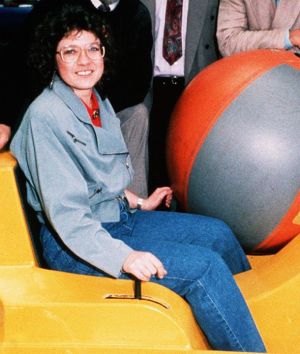Janet Trewin
| Janet Trewin | |
|---|---|
 Trewin in 1992. Trewin in 1992. | |
| Full Name | Janet Trewin |
| Nationality |
|
| Sex | Female |
| Occupation | Presenter of Top Gear (1977 TV series) |
| On-screen debut | Top Gear: Series 26, Episode 7 (1991) |
| Final appearance | Top Gear: Series 31, Episode 6 (1994) |
Janet Trewin was a British television and radio presenter, and occasionally motoring journalist who primarily worked for the BBC and who helped to present for the original incarnation of Top Gear between 1991 and 1994, making nine[1] total appearances. Though never a particularly integral member of the presenting team, she was nonetheless deemed significant enough to appear in various pieces of promotional material for Top Gear throughout the 1990s, including the programme's 1993 Radio Times cover appearance.
Early life[edit | edit source]
Born in March 1957[2], Janet Trewin attended[3] Red Maids School in Bristol from 1968 until 1975, before studying law at Bristol Polytechnic Law School, graduating in 1978. She would join the BBC and make her first appearances a year later, helping to present Woman's Hour[4] alongside Jenni Murray, and eventually becoming Radio 1's first ever female newsreader on its programme Newsbeat from 1981[5] through to September[6] 1986, during which time she would present over 200 installments. She would then make the transition to television by helping to present Newsnight[7] between June 1988 and May 1990.
Career in automotive journalism[edit | edit source]
In January 1991, Trewin would return[8] to the radio by presenting Going Places, a transport-themed radio show on BBC Radio 4 which focused on innovations and issues faced within the automotive and transport industries. Whilst presenting Going Places, she would be occasionally accompanied[9] by Top Gear veteran Chris Goffey, who likely aided in her inclusion to Top Gear later that year. Beginning from September 1993, she would be permanently joined by former Top Gear presenter Peter Macann, and together the pair would present 42 further installments of the programme until its cancellation[10] in July 1994.
On Top Gear[edit | edit source]
Janet Trewin would make her Top Gear debut for Halloween 1991, appearing in the seventh episode of the programme's 26th series to present a segment on female drivers feeling more at risk, primarily whilst stranded[11] at motorways or at car parks. She was likely brought onboard the programme due to the simultaneous departures of Sue Baker and Beki Adam, the former due to presenting similar subject matter and the latter due to being a relatively young female host who had since grown disillusioned with the programme. Later that same series, Trewin would also present films on benzene gas in the atmosphere and the problem of youth joyriding, suggesting banger racing as a crime-free alternative. In 1992, she would be one of the Top Gear presenters participating[12] in a game of Motaball, a type of automotive football played with modified hovercraft. During her final year on the programme, she would present films on driver fatigue and motion sickness before stepping down from the programme altogether in 1994. Her role on the show would be replaced by Andy Wilman and Michele Newman, the pair presenting segments on similar topics.
Fluorolastomec controversy[edit | edit source]
In Series 27, Episode 2 of Top Gear, which aired on the 5th March, 1992, Top Gear would present a segment based on the alleged dangers of 'Fluorolastomec', otherwise known as Veton[13] (occasionally spelt Viton), a chemical compound supposedly formed by burnt plastic and rubber components in motor vehicles as a result of automotive fires, and upon contact with skin, even through protective clothing, would cause an irreversible degenerative reaction that would eat away at a victim's skin until amputation was needed or succumbed to their injuries. This was summarily debunked[14] two months after the programme's broadcast by the Chicago Tribune, but the rumour persisted throughout the first half of the 1990s.
References[edit | edit source]
- ↑ IMDb - Janet Trewin.
- ↑ GOV.UK - Janet Trewin personal appointments.
- ↑ LinkedIn - Janet Trewin.
- ↑ BBC Genome - Woman's Hour. (27th July, 1979)
- ↑ BBC Genome - Steve Wright. (20th April, 1981)
- ↑ BBC Genome - Newsbeat. (19th September, 1986)
- ↑ BBC Genome - Newsnight. (15th June, 1988)
- ↑ BBC Genome - Going Places. (18th January, 1991)
- ↑ BBC Genome - Going Places. (29th March, 1991)
- ↑ BBC Genome - Going Places. (1st July, 1994)
- ↑ BBC Infax database.
- ↑ BBC Genome - Top Gear. (19th March, 1992)
- ↑ Usenet discussion from 1994 - FLUOROLASTOMEC or VETON.
- ↑ Mateja, J. (1992) 'WARNING: THIS WARNING MAY, OR MAY NOT, SAVE YOUR SKIN.', Chicago Tribune, 29th May.
[edit | edit source]
| |||||||||||
- British automotive journalists
- Janet Trewin
- Profile pages
- Female automotive journalists
- Presenters of Top Gear (1977 TV series)
- Female presenters of Top Gear (1977 TV series)
- Automotive journalists who made their on-screen debuts in 1991
- Automotive journalists who made their final on-screen appearances in 1994